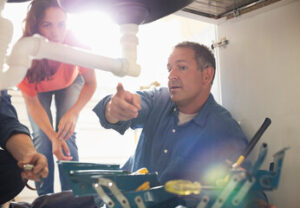Tree service professionals are experts in diagnosing the health of every shrub, bush and tree on your property. If you notice a lot of dead leaves or bare branches, holes in the trunk or bark and brittle roots, then it’s time to call an accredited tree service company.
Tree Service Irvine CA companies also offer a variety of other services. Be prepared to discuss what you’d like them to do before hiring someone.

Tree pruning is an important part of overall tree care, and a professional can make sure that your trees are properly pruned and healthy. The right pruning techniques help maintain the balance and structure of your landscape, while preventing damage to structures, utility lines, or other properties. It is also a way to stimulate the growth of new branches and limbs, and can improve the aesthetics of your property.
Tree service companies can also perform emergency services, including cutting down dead trees that pose a threat to your home or the neighborhood. They can also help rehabilitate damaged trees by performing tree cabling and bracing, which strengthens weaker branches and helps them support themselves in future storms.
When you choose a reputable tree service company, they will have certified arborists on staff and adhere to industry standards for safety protocols. In addition, they will have the proper equipment to complete the job safely and efficiently. This will ensure that the work is completed without any risk to your property, your health, or the lives of their employees.
In addition to trimming and pruning, tree service providers can also offer other residential and commercial tree services, such as stump grinding, land clearing, and tree planting. They can also work with local governments and municipalities on larger-scale projects and provide hazard assessments for public property.
A quality tree service company will have extensive knowledge of various species and varieties. They will know how often different types of trees need to be trimmed, and they can give you a thorough assessment of your property to recommend the best course of action. They can also help you design a comprehensive plan for your property that includes pruning, thinning, and elevating.
In densely populated urban environments, trimming and pruning can be more complicated than in rural areas. For example, city residents are often worried about their trees’ proximity to buildings and power lines. A reputable tree service company can trim your trees to keep them healthy and safe while reducing the risk of damage or accidents. They will also have experience in working with different types of trees and will be able to identify any potential problems before they become serious.
Tree Removal
A tree service company will prune and trim your trees to keep them healthy, attractive, and safe. These companies also provide stump grinding and removal services as well as clearing brush from your property. Additionally, they will remove insect infestations, dead or diseased branches, branches that rug together, and branch stubs. They also take care of other maintenance tasks such as clearing dead limbs and fallen tree limbs from sidewalks, driveways, and roads.
Tree removal is a dangerous and specialized task that should only be performed by professionals. If a tree is in the process of falling over, a professional will cut a notch into it to control its fall direction and may use ropes or a crane to take it down in sections. Attempting to fell a tree yourself can be extremely dangerous and result in serious injury or significant property damage.
Arborists, who are typically employed by tree services, have the knowledge and skills to safely take down a tree and remove it from your property. They have a thorough understanding of the various factors that go into removing a tree, including its location and whether or not it is close to power lines or other hazards.
If you notice a dead tree in public spaces, call 311 or submit a request through the City’s online system. NYC Parks will inspect the site and, if necessary, remove the dead tree. In general, the City prioritizes work to address the highest risks first.
A tree services company will also prune and trim your trees to prevent encroaching on other properties or damaging structures, like sidewalks, driveways, and property foundations. They can also diagnose and treat a variety of diseases that attack trees, such as spruce budworm and pine beetle.
When you hire a tree service, make sure to ask for quotes from several different companies and interview each one to gauge professionalism, expertise, and customer service. A reputable company will be licensed and insured, so you can rest assured that they will do a quality job while following all the required safety protocols.
Stump Grinding
Stump grinding is the process of cutting a tree stump down to its roots using specialized equipment. Stumps that have been left to rot can ruin a landscape, making it look shabby. They are also a safety hazard that can cause tripping and falling accidents. Besides, they can attract pests and diseases to the surrounding soil. Therefore, it is important to hire a professional for stump grinding services. There are various companies that offer stump grinding services, and it is important to compare their prices and quality. A reputable company will be experienced and will have the necessary tools to ensure that the job is done correctly. They will also offer a variety of stump sizes, so you can find the right one for your property.
A good stump grinding service will take into account the type and age of the stump and its root system. It will also determine the amount of time it will take to grind a stump and whether a deep or shallow grind is required. Unlike complete removal, which involves digging up the stump and its roots, stump grinding leaves the roots in the ground, which makes it less expensive. However, the roots will eventually suffocate other plants in the area and may need to be removed completely.
The company’s team of tree experts will grind the stump into wood chips, allowing you to use it for landscaping purposes or dispose of it as yard waste. It is a quicker and less invasive option than removing the entire stump, and it can be used to level uneven or hilly terrain. It is a great choice for new homeowners who want to improve their curb appeal and for those who want to replant a tree where an old one once stood.
Located in Long Island, NY, Owens Bros Tree Service is a family-owned and operated business that serves commercial and residential clients. It provides tree trimming, pruning, stump grinding and landscaping services. The company also offers emergency storm services. Its employees are licensed and insured, and they work with a goal to create long-term relationships with customers. They are available 24/7, and appointments can be made online or over the phone.
Pest Extermination
Like all living things, trees are susceptible to diseases and pest infestations, especially if they’re stressed by environmental conditions or human activity. While soil health management helps prevent many ailments, fungal infections, bacterial diseases and insect problems can still emerge. Periodic inspections and treatment programs are the best ways to catch and treat these problems before they become serious enough to require drastic measures or removal.
The first warning signs of a disease or pest problem vary from tree to tree and from type to type, but often include damage to leaves, bark, branches and twigs. Bartlett operates a modern diagnostic laboratory to support our pest management services, enabling us to quickly and accurately identify the cause of a problem, develop effective treatment programs and protect your landscape investment.
In addition to treating existing infestations of fungi, insects and other pests, we also offer biological control services by releasing beneficial insects to suppress damaging populations and encourage healthy plant growth. And when chemical treatments are necessary, we use only organic and environmentally responsible products to suppress pests while protecting people, pets, property and the environment.








